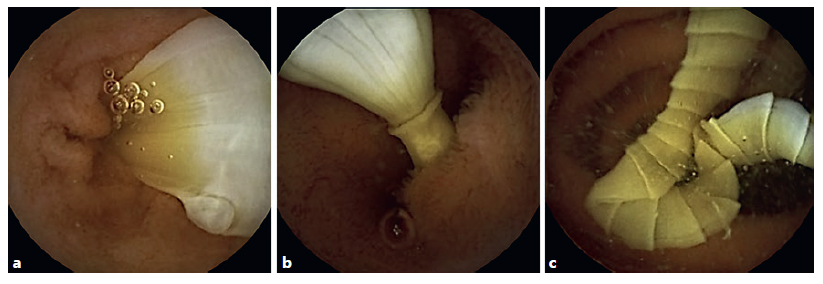Taeniasis is a parasitic infection caused by tapeworm species (Taenia saginata, Taenia solium, and Taenia asiatica), affecting about 50 million people globally. It occurs mainly in developing countries, by consumption of undercooked infected meat [1]. Its diagnosis is challenging as most patients remain asymptomatic or have mild nonspecific symptoms [2, 3]. Although microscopic stool examination remains the gold standard for its diagnosis, it has a low diagnostic yield [4]. Small bowel capsule endoscopy (SBCE) is an essential diagnostic tool for small intestine diseases. SBCE may help in stool-negative tapeworm infection cases, allowing a definitive diagnosis [3, 5].
We report a case of an 18-year-old young female patient, from a developed country, living in an urban area with sanitary conditions, with no past medical history and chronic medication, that was referenced to gastroenterology consultation for bloating, abdominal pain, and intermittent white cords in her stools during approximately 6 months, not seen by physicians. The patient did not report a previous consumption of undercooked meat and has no recent out-of-country travel. There were no relevant findings in the physical examination or the biochemical analysis. The microbiological stool examination, collected on three different days, was negative. Upper and lower gastrointestinal endoscopy had no relevant findings. Therefore, an SBCE was performed. Throughout the small intestine, a continuous segment of white, flat, and segmented structures (proglottids) without mucosal lesions were observed, compatible with intestinal tapeworm infection (shown in Fig. 1). The patient was treated with a single dose of praziquantel 10 mg/kg with full clinical resolution and was advised to properly cook meat. We performed additional stool testing 4 months after the treatment, and it was negative. Currently, with approximately 2 years of follow-up, the patient remains asymptomatic, without reporting white cords (proglottids) in her stools.

Fig. 1 SBCE findings. a-c Tapeworm in the small bowel. c A continuous segment of white, flat, and segmented structures without mucosal lesions.
We emphasize that, although SBCE allows direct visualization of the tapeworm, and it was decisive for establishing the diagnosis in this case, it has the drawback of not giving information of the type of Taenia species. This information is important in cases of Taenia solium infection, given the potential risk of neurocysticercosis. Nevertheless, this case illustrates a very rare diagnosis in developed countries, highlights the diagnostic challenges of some cases of tapeworm infection, and reveals that SBCE may play a crucial role in the diagnosis of taeniasis in suspected cases with negative microscopic stool examination and nonspecific symptoms.















